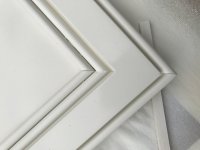Twoodman66
Member
- Joined
- Feb 27, 2016
- Messages
- 96
Hi All
Trying my best to match existing kitchen cabinet profile for pantry add on
Doors are mitered with dominos. What is the best way to fill my black lines??
Pic is door with two coats of kem aqua surfacer already applied.miters looked a lot better prior to applying finish.if we were brushing finish on I would just flood the joint and let it dry. Any advise is greatly appreciated
Best
Kevin
Trying my best to match existing kitchen cabinet profile for pantry add on
Doors are mitered with dominos. What is the best way to fill my black lines??
Pic is door with two coats of kem aqua surfacer already applied.miters looked a lot better prior to applying finish.if we were brushing finish on I would just flood the joint and let it dry. Any advise is greatly appreciated
Best
Kevin

